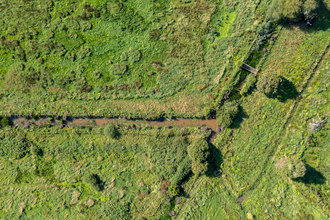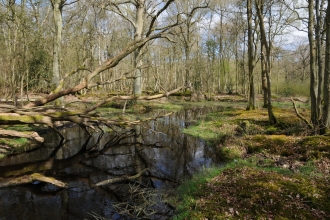Managing trees for nature
Essential habitat and safety work across our nature reserves
Throughout summer and autumn, Hampshire and Isle of Wight Wildlife Trust will be carrying out tree management and habitat restoration works across several of our nature reserves.
These works have been developed by our reserve and land management teams, with input from our ecology team through site assessments, to enhance habitats, improve public safety, and ensure that our landscapes remain resilient for wildlife and people alike.
Tree work can sometimes appear dramatic, but it is an essential step in helping restore and maintain important habitats - including rare and threatened ones like heathlands and wet woodlands - while also improving safety and protecting infrastructure such as paths and powerlines.
All activities are in line with conservation best practices and habitat restoration plans, and are carried out following ecological surveys and, where necessary, under full licensing and regulation.
Habitat restoration and improved road safety at Hook Common and Bartley Heath, North Hampshire
From 1st September, approximately three hectares of woodland at Hook Common and Bartley Heath will be clear-felled as part of an essential project to restore rare wooded heath habitat and improve road safety. The work will take place on both the north and south sides of the A287 dual carriageway, focusing on the narrow, public-facing woodland edges.
The area has become dominated by dense birch and scrub due to a lack of previous management. The clearance will help restore balance by opening up the landscape and allowing heather and other heathland species to regenerate. The result will be the re-establishment of wooded heath – a nationally rare habitat made up of open heathland with scattered trees, particularly oak.
Tom Hilder, Senior Nature Based Solutions Officer (practical delivery)at Hampshire and Isle of Wight Wildlife Trust said:
“Although the felling may appear drastic at first, it is a vital step in restoring ecological balance. We carefully assess each tree’s health, species, and ecological value. Only selected trees, mostly birch and aspen, are being removed.
“This work will lead to a richer, more biodiverse and resilient habitat, benefiting a range of species including rare adders, tree pipits, or heather-dependent insects.”
The habitat restoration is especially beneficial for tree pipits, a species which has suffered a significant decline. Despite their name, they prefer open woodland edges, particularly on wooded heathland edge habitats. The project will replace dense, less suitable woodland with a more favourable structure of scattered tree and edge habitat woodland - creating ideal nesting and feeding conditions which they need to thrive. With a 29% reduction in their UK breeding range since the 1960s, restoring this habitat could make a real difference for their future.
The project also plays a key role in supporting the Adder Project in Hook North, which aims to safeguard one of Hampshire’s most threatened reptile populations. By removing dense vegetation and opening up the woodland structure, the work will create a warmer, sunnier environment with areas of bare ground - ideal conditions for adders and other reptiles. It will also improve habitat connectivity by establishing open corridors that allow these species to move more freely and safely across the landscape.
Ground-level assessments by our ecology team have confirmed there are no active nests or protected species present. All the work is fully licensed and supported by The Forestry Commission and Natural England.
The work will take approximately four weeks (weather dependent), and at times large machinery will be present. We are working to minimise disruption with felling taking place under a licensed, safe extraction route recommended by our ecology team.
Reducing safety risks, protecting wildlife and restoring heathland at Roydon Woods Nature Reserve, New Forest
From 17th to 24th September 2025, Hampshire and Isle of Wight Wildlife Trust will carry out important tree management work at Roydon Woods Nature Reserve, timed to coincide with a scheduled shutdown of the Scottish and Southern Energy (SSE) powerlines that cross the commons.
This temporary shutdown provides a rare opportunity to safely access areas immediately adjacent to the powerlines - zones that are normally off-limits due to electrical safety risks. The works will involve the removal of Scots pine, birch, and a small number of oaks that have the potential to hit the powerlines. These trees have not been actively managed for decades, and this planned felling will help future-proof the site, reducing the need for emergency works and keeping the area safe and accessible.
In addition to improving safety, the clearance supports our ongoing efforts to restore open heathland habitat. Removing these trees will widen habitat corridors, improve connectivity across the heath, and support species that depend on open sunlit environments.
Martin Boxall, Forestry Manager at Hampshire & Isle of Wight Wildlife Trust said: “Roydon Woods is a very special place – a mix of ancient woodland and open heath that supports a diverse range of wildlife.
“This project is a unique opportunity to tackle long-overdue tree management in a safe and coordinated way. By removing pines, birch and a few oaks that potentially threaten the power lines, we’re not only reducing long-term safety risks but also enhancing heathland habitat - one of the UK’s most threatened ecosystems.
“By restoring open heathland corridors, we create more space and sunlight for low lying heathland plants such as heather, better hunting and basking areas for rare reptiles such as adders, and improved flight and nesting conditions for ground-nesting birds such as nightjars and woodlarks.
“Roydon Woods is one of the few places where you can still find this combination of habitats and species. This project is essential for protecting nature, and making our landscapes more resilient for the future for both wildlife and people.”
Some permissive paths in the area are already closed and will remain so during the work, and may stay closed for a time afterwards to allow for safe completion of the project. While one section of the skyline will change, the overall visual impact on the landscape will be limited. The work is also expected to generate a large quantity of timber, which will be processed sustainably.
Eastern Yar River Restoration Project, Isle of Wight
Along the Eastern Yar river (including Newchurch Moors, Alverstone Mead, Lower Knighton, Sandown Meadows, Morton Marsh nature reserves), we’re entering the second phase of a two-year project to improve habitat condition for wetland species.
As part of this project, tree works will begin on 18th August, focusing particularly on the removal of declining willow and scrub at Lower Knighton, along the cycle track. This clearance will create space and light for the herb rich fen community to recover in areas where tree cover has shaded it out. It will also reduce tree fall risk, and benefit wetland wildlife. Please be aware there may be temporary access disruption while timber is extracted from Lower Knighton across the cycle track to Newchurch Moors. We thank cycle track users for their patience in advance for their cooperation and understanding.
From 1st September, the project will focus on river restoration, re-profiling sections of the main channel and surrounding land to restore wetland habitats for wildlife and improve flood mitigation. Throughout September, diggers will be on site at Newchurch Moors, Alverstone Mead, and Sandown Meadows to lower sections of the raised riverbanks, reconnecting the channel with the floodplain and making use of its natural flood storage capacity.
At Alverstone Mead and Sandown Meadows, drainage ditches will also be re-profiled and shallowly excavated to form new wetland features such as ponds and scrapes. These will provide additional flood storage, re-wet drained areas, and encourage the return of wetland flora and fauna.
All works are scheduled for completion by the end of September.
Emma Hunt, Senior Reserves Officer on the Island at Hampshire and Isle of Wight Wildlife Trust, said:
“Although the works may appear drastic, this Capital Works Programme has been carefully designed to re-naturalise the Eastern Yar floodplain, restore damaged wetland habitats, and promote biodiversity.”
“The trees and scrub being removed were specifically chosen because they are in decline. The rapid spread of willow has created dense shade, preventing light from reaching the fen. By clearing these areas, we are managing light, allowing the herb-rich fen community to recover and biodiversity to flourish.”
“The river restoration element addresses the historic disconnection of the main river channel from its floodplain caused by dredging. Currently, during heavy rainfall, water is forced to rush downstream within the channel, increasing the risk of flash flooding at pinch points such as culverts. Restoring the river’s natural connection to the floodplain will help reduce this risk while creating valuable wetland habitat.”
Find out more about this Captial Works Programme.
Why This Work Matters
Tree management is a vital part of modern conservation. Left unmanaged, many of our most precious open habitats – like heathlands and wetlands – are lost to encroaching woodland. While trees are essential, it’s about having the right habitat in the right place.
Our work across these sites supports:
- Biodiversity, by restoring the specialist conditions many rare species need
- Climate resilience, through healthy and functioning ecosystems
- Public safety, by removing high-risk trees and improving visibility along paths and roads
- Long-term sustainability, by planning proactively and reducing future reactive work
Thank you for your understanding while this important work is carried out. If you have any questions or concerns, please contact us at info@hiwwt.org.uk.



